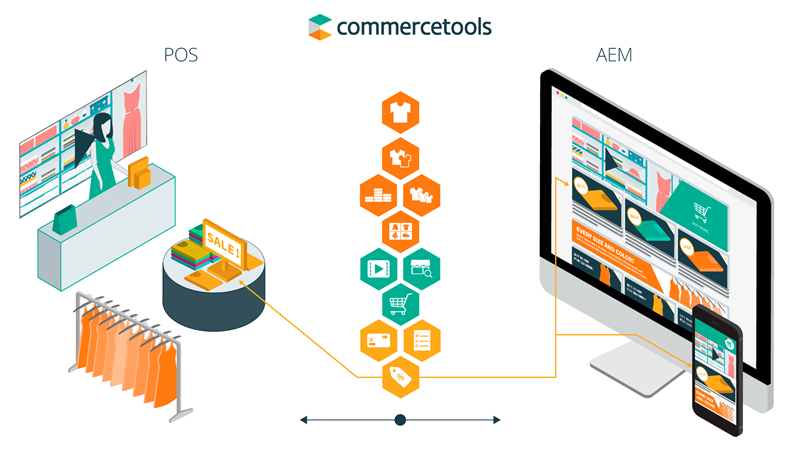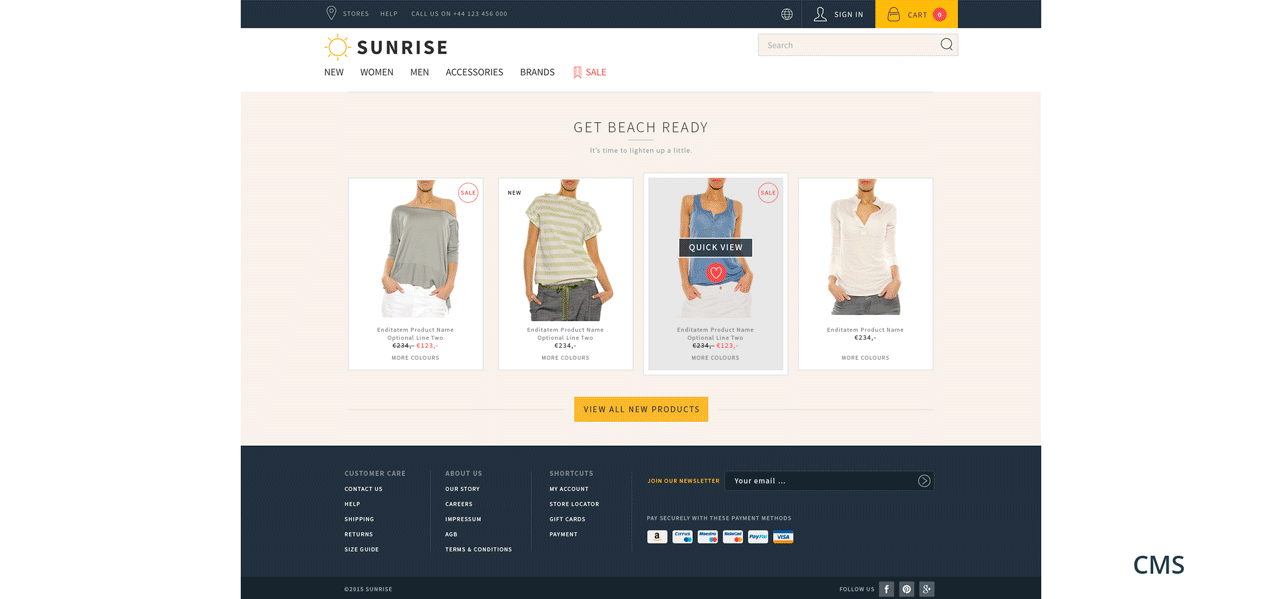commercetools' Microservices Commerce Platform for Adobe
commercetools, a cloud commerce platform provider, today unveiled commercetools for Adobe Marketing Cloud, which is the first microservices-based platform to enable fluid experiences in Adobe Experience Manager (AEM), at Adobe Summit. The release just came after the announcement was made during NRF Retail’s Big Show in New York about the partnership between Adobe and commercetools.
We have reached out to Arthur Lawida, President of  commercetools, Inc, to get his inside scoope of what the new release adresses, and he told us: “The problem with executing in a real-time, fluid environment is that old commerce systems have development lead-times that work in month cycles, not days. Every element in the equation must be done in orchestration, which also drives up cost. An API-based commerce approach is virtually plug-and-play. Retailers can update the commerce solution in about the same time frame it takes to create and update marketing content through the CMS.” In the press release, he also advised clients to not just design an experience for a single commerce-enabled website and crop it to a new form factor, but to start with the brand experience and envision commerce everywhere. “It is only when retailers modernize their commerce platform that they can be agile enough for the future and think beyond commerce as a desktop website,” added Lawida.
commercetools, Inc, to get his inside scoope of what the new release adresses, and he told us: “The problem with executing in a real-time, fluid environment is that old commerce systems have development lead-times that work in month cycles, not days. Every element in the equation must be done in orchestration, which also drives up cost. An API-based commerce approach is virtually plug-and-play. Retailers can update the commerce solution in about the same time frame it takes to create and update marketing content through the CMS.” In the press release, he also advised clients to not just design an experience for a single commerce-enabled website and crop it to a new form factor, but to start with the brand experience and envision commerce everywhere. “It is only when retailers modernize their commerce platform that they can be agile enough for the future and think beyond commerce as a desktop website,” added Lawida.
Adobe has recently released the latest version of its web content management system, Adobe Experience Manager (AEM) 6.3 in an effort to help organizations deliver experiences through “affiliated properties” like partner websites, Internet of Things (IoT) devices and mobile apps. Previously, during NRF Retail’s Big Show, in conjunction with the partnership with commercetools, Adobe also announced a Fluid Experiences for Retail capability through its Adobe Experience Manager, in order to enable retailers to create and manage omnichannel experiences across any touchpoint, including in-store associate apps, social channels, physical signage, Internet of Things (IoT) devices, and smart-screens. Fluid Experiences automatically edits and resizes images and copy based on the channel, so the content gets optimized for each touchpoint.
commercetools is optimized to support Experience Manager’s newly announced capabilities to support fluid experiences, enabling brands to quickly and easily inject commerce everywhere; including in-store associate apps, digital signage, mobile and IoT devices, and social commerce to create context-specific transactions. According to the company, an extensive library of commerce services like product, fulfillment and customer data connects via commercetools’ Smart Commerce APIs to fluid experiences with Experience Manager.
Advantages of commercetools for Adobe Marketing Cloud
-
In Deloitte’s Global Powers of Retailing Report 2017, the top 250 retailers average a net profit margin of 3 percent. So retailers do not have the luxury to throw a bunch of technology investments against a wall and wait to see what sticks. Now that Adobe’s web content management system is connected to commercetools’ open, cloud-native, microservices-based commerce platform, retailers can maximize their Adobe investments.
-
Consumers do not really care whether they end up making their purchase on the company’s website or one of its social channels because they expect the user experience to be so coherent regardless of the platform or device that they are on. Therefore, while retailers deliver experiences across all touchpoints with AEM, commercetools injects these buying opportunities with a set of application programming interfaces (APIs).

-
Keeping up with today’s ever-changing ways of customer interaction requires the flexibility to launch cutting-edge apps that engage your customers on any device without sacrificing security and without breaking your budget. Since commercetools’ open commerce platform architecture supports the microservices approach, joint users can cut down development times and respond quickly to new market conditions. “For years retailers have been striving to create effective, memorable omnichannel experiences for their customers, but they’re wrestling with disjointed tools and inflexible architectures,” said Errol Denger, director of commerce strategy at Adobe. “commercetools’ modern microservices commerce solution empowers Experience Manager customers to quickly apply commerce-enabled content everywhere, creating contextually appropriate experiences reflective of the brand.”
-
Since the platform is exclusive for Adobe, for e-commerce development, developers can build up their expertise on Adobe’s platform.
-
commercetools charges no license fees as users pay for what they use each month which provides flexibility in terms of creativity and building innovative commerce solutions.
-
The commercetools platform also offers a pre-defined library of microservice components that are exposed directly into Experience Manager, meaning that users can focus all asset creation and management on Adobe and develop deep in-house expertise.
A key differentiator between commercetools and other commerce platforms is that through its API-first principle, it’s highly flexible and a great fit for new e-commerce approaches like microservices. The API of the commercetools platform provides an interface for programmatic access to the data stored on the commercetools platform and the associated functionality. Last week, our tech reporter Laura Myers interviewed Kelly Goetsch, Chief Product Officer at commercetools, on the emerging new touchpoints between retailers and consumers, and he emphasized the importance of building an API strategy that will power organizations’ digital transformation:
“These days, every electronic consumer device has some type of an interface and an application environment that you can bold applications for. All of those consumed APIs as the lowest common denominator. It is not very likely that you build an app specifically for each one of these thousand different small fragmented platforms but instead, the new approach is to build in exposed APIs and publish those catalogs of any organization can then build an interface that a social media or any electronic device can consume those APIs.”
Through the end of last year, I reviewed the top six enterprise e-commerce platforms including commercetools. In my review, I mentioned that the only real limitation with the platform was that you need to have a CMS framework in place to utilize the commerce platform and build your content channels around. However, in the case of integration with Adobe, this can represent an advantage as users will reduce the number of resources required and enable greater Adobe specialization due to not having to connect a third-party CMS. As a result, businesses will maximize their investments in Adobe’s solutions.

Ever-changing customer expectations for a seamless flow between touchpoints are shaping the future of e-commerce technology. Therefore, vendors like Adobe and commercetools are consistently looking for new ways of offering capabilities that enable their users to create and manage omnichannel experiences across any touchpoint. With the new commercetools solution tightly integrated with Adobe Experience Manager, marketers will be able to inject commerce wherever can make their marketing campaigns more intuitive. If you are interested in hearing more on “headless commerce,” stay tuned as in the upcoming days, here at CMS-Connected, we will be diving further into that topic.

Venus Tamturk
Venus is the Media Reporter for CMS-Connected, with one of her tasks to write thorough articles by creating the most up-to-date and engaging content using B2B digital marketing. She enjoys increasing brand equity and conversion through the strategic use of social media channels and integrated media marketing plans.